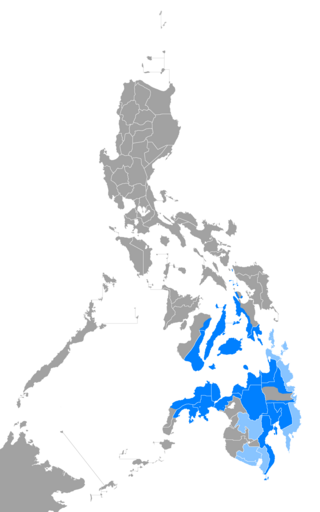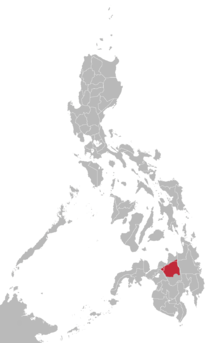A syllable is a unit of organization for a sequence of speech sounds typically made up of a syllable nucleus with optional initial and final margins. Syllables are often considered the phonological "building blocks" of words. They can influence the rhythm of a language, its prosody, its poetic metre and its stress patterns. Speech can usually be divided up into a whole number of syllables: for example, the word ignite is made of two syllables: ig and nite.
Unless otherwise noted, statements in this article refer to Standard Finnish, which is based on the dialect spoken in the former Häme Province in central south Finland. Standard Finnish is used by professional speakers, such as reporters and news presenters on television.
Î, î (i-circumflex) is a letter in the Friulian, Kurdish, Tupi alphabet, Persian Rumi script, Romanian alphabets and Phonetic Filipino. This letter also appears in French, Turkish, Italian, Welsh and Walloon languages as a variant of letter “i”.

Cebuano, natively called by its generic term Bisaya or Binisaya and sometimes referred to in English sources as Cebuan, is an Austronesian language spoken in the southern Philippines. It is spoken by the Visayan ethnolinguistic groups native to the islands of Cebu, Bohol, Siquijor, the eastern half of Negros, the western half of Leyte, and the northern coastal areas of Northern Mindanao and the Zamboanga Peninsula. In modern times, it has also spread to the Davao Region, Cotabato, Camiguin, parts of the Dinagat Islands, and the lowland regions of Caraga, often displacing native languages in those areas.
Palauan is a Malayo-Polynesian language native to the Republic of Palau, where it is one of the two official languages, alongside English. It is widely used in day-to-day life in the country. Palauan is not closely related to other Malayo-Polynesian languages and its exact classification within the branch is unclear.

Maranao is an Austronesian language spoken by the Maranao people in the provinces of Lanao del Norte and Lanao del Sur in the Philippines, and in Sabah, Malaysia.
Like many other languages, English has wide variation in pronunciation, both historically and from dialect to dialect. In general, however, the regional dialects of English share a largely similar phonological system. Among other things, most dialects have vowel reduction in unstressed syllables and a complex set of phonological features that distinguish fortis and lenis consonants.

Masbateño or Minasbate is a member of Central Philippine languages and of the Bisayan subgroup of the Austronesian language family spoken by more than 724,000 people in the province of Masbate and some parts of Sorsogon in the Philippines. Masbatenyo is the name used by the speakers of the language and for themselves, although the term Minásbate is sometimes also used to distinguish the language from the people. It has 350,000 speakers as of 2002, with 50,000 who speak it as their first language. About 250,000 speakers use it as their second language.
The Persian language has between six and eight vowels and 26 consonants. It features contrastive stress and syllable-final consonant clusters.
Wintu is an extinct Wintuan language which was spoken by the Wintu people of Northern California. It was the northernmost member of the Wintun family of languages. The Wintuan family of languages was spoken in the Sacramento River Valley and in adjacent areas up to the Carquinez Strait of San Francisco Bay. Wintun is a branch of the hypothetical Penutian language phylum or stock of languages of western North America, more closely related to four other families of Penutian languages spoken in California: Maiduan, Miwokan, Yokuts, and Costanoan.
The phonological system of the Hawaiian language is based on documentation from those who developed the Hawaiian alphabet during the 1820s as well as scholarly research conducted by lexicographers and linguists from 1949 to present.
The Tawbuid language is a language spoken by Tawbuid Mangyans in the province of Mindoro in the Philippines. It is divided into eastern and western dialects. The Bangon Mangyans also speak the western dialect of Tawbuid.
Abellen, Abenlen, Aburlin, or Ayta Abellen, is a Sambalic language. It has about 3,500 speakers and is spoken in a few Aeta communities in Tarlac province, Philippines. Ayta Abellen itself is part of the Sambalic language family in the Philippines and is closely related to not only the five other Ayta dialects but also the Botolan dialect of Sambal. Ethnologue reports 45 monolinguists.
Taos is a Tanoan language spoken by several hundred people in New Mexico, in the United States. The main description of its phonology was contributed by George L. Trager in a (pre-generative) structuralist framework. Earlier considerations of the phonetics-phonology were by John P. Harrington and Jaime de Angulo. Trager's first account was in Trager (1946) based on fieldwork 1935-1937, which was then substantially revised in Trager (1948). The description below takes Trager (1946) as the main point of departure and notes where this differs from the analysis of Trager (1948). Harrington's description is more similar to Trager (1946). Certain comments from a generative perspective are noted in a comparative work Hale (1967).
The phonology of the Zuni language as spoken in the southwestern United States is described here. Phonology is a branch of linguistics that studies how languages or dialects systematically organize their sounds.
This article explains the phonology of Malay and Indonesian based on the pronunciation of Standard Malay, which is the official language of Brunei, Singapore and Malaysia and Indonesian which is the official language of Indonesia and a working language in Timor Leste. Bruneian Standard Malay and Malaysian Standard Malay follow the Johor-Riau Pronunciation, while Singaporean Standard Malay and Indonesian follow the Baku Pronunciation.
Tboli, also Tau Bilil, Tau Bulul or Tagabilil, is an Austronesian language spoken in the southern Philippine island of Mindanao, mainly in the province of South Cotabato but also in the neighboring provinces of Sultan Kudarat and Sarangani. According to the Philippine Census from 2000, close to 100,000 Filipinos identified T'boli or Tagabili as their native language.

The Sama language, Sinama, is the language of Sama-Bajau people of the Sulu Archipelago, Philippines; Sabah, Malaysia and parts of Indonesia. The Sama are one of the most widely dispersed peoples in Southeast Asia.
The Bantayanon language is the regional language of the Bantayan islands in the Philippines. It is a part of the Bisayan language family and is closely related to Waray and Hiligaynon. There are three dialects of Bantayanon, based in the three municipalities that comprise the island group: Binantayanun, Linawisanun, and Sinantapihanun, the most idiosyncratic of the three. There are also significant dialectal differences between the speech patterns of those that live in the town centers and those that live outside of the more rural areas of the islands.

Ilocano is an Austronesian language spoken in the Philippines, primarily by Ilocano people and as a lingua franca by the Igorot people and also by the native settlers of Cagayan Valley. It is the third most-spoken native language in the country.





